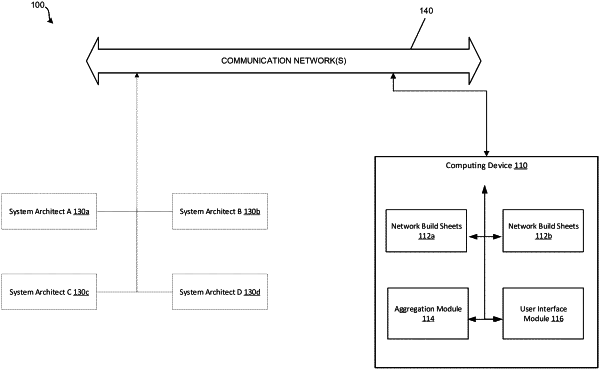| CPC H04L 41/12 (2013.01) [H04L 41/082 (2013.01); H04L 41/16 (2013.01); H04L 41/22 (2013.01)] | 12 Claims |

|
1. A system comprising:
a processor device; and
a non-transitory computer-readable memory including instructions that are executable by the processor device to perform operations comprising:
receiving a plurality of network build sheets generated by a network design tool based on a plurality of network architectures input to the network design tool by one or more system architects, each network build sheet of the plurality of network build sheets corresponding to a proposed respective network architecture for a respective subpart of an overall computer network, the proposed respective network architecture indicating an anticipated computing demand for the respective subpart of the overall computer network, the anticipated computing demand corresponding to a predetermined time in the future, the proposed respective network architecture being designed by the one or more system architects using the network design tool;
aggregating the plurality of network build sheets together to generate holistic build data for the overall computer network;
receiving a request from a user to access a graphical user interface configured to display the holistic build data;
determining an access level associated with the user;
generating the graphical user interface that includes a graphical representation of at least a portion of the holistic build data, the graphical representation being customized based on the access level associated with the user;
generating a demand forecast that comprises a plurality of anticipated computing demands at a plurality of different points in time between a current time and the predetermined time in the future, wherein the demand forecast indicates a trend of computing demand from a present computing demand at the current time to the anticipated computing demand at the predetermined time in the future;
executing a trained machine-learning model to determine the anticipated computing demand for the respective subpart of the overall computer network at the predetermined time in the future;
determining, based on the anticipated computing demand for the respective subpart of the overall computer network at the predetermined time in the future, an amount of computer hardware to acquire to satisfy the anticipated computing demand for the respective subpart of the overall computer network at the predetermined time in the future; and
initiating a computer hardware-acquisition operation using the amount of computer hardware for satisfying the anticipated computing demand.
|